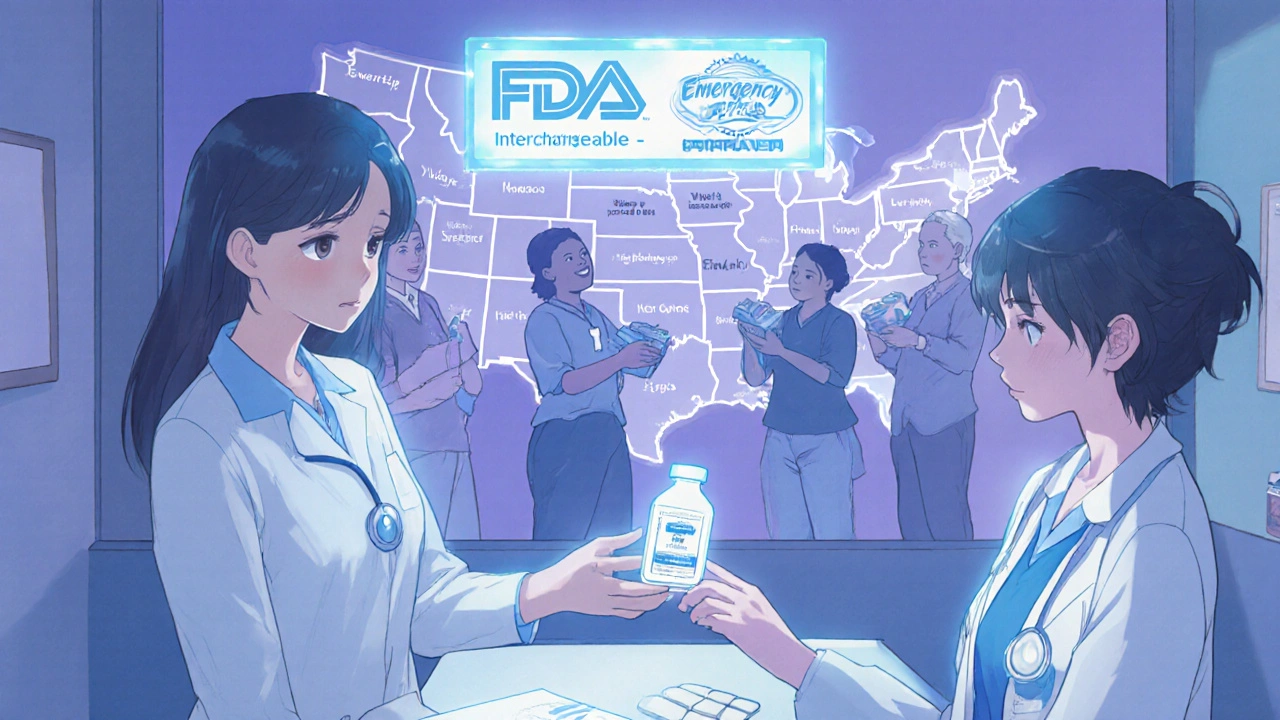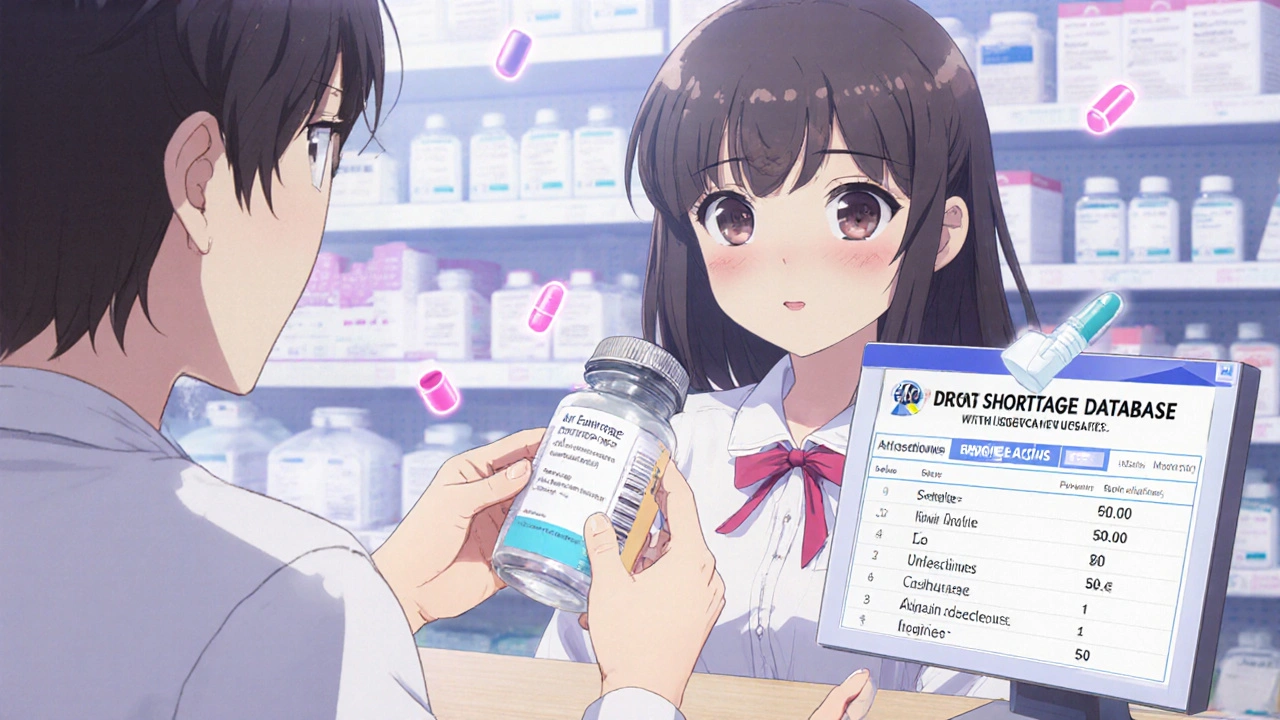When your medication runs out and no pharmacy has it in stock, it’s not just inconvenient-it’s dangerous. In 2025, over 1,961 prescription drugs were in shortage across the U.S., with more than half of those shortages lasting two years or longer. This isn’t a rare glitch. It’s the new normal. Whether it’s insulin, antibiotics, chemotherapy drugs, or even basic pain relievers, running out can mean skipped doses, worsening symptoms, or worse. But you’re not powerless. Here’s exactly what to do when your medication disappears from the shelf.
Check the FDA Drug Shortage Database First
The first thing you should do when you can’t find your drug is go to the FDA Drug Shortage Database. It’s free, updated daily, and lists every active shortage with official alternatives. You don’t need a login. Just type in your drug name. If it’s listed, the FDA will tell you:- Which manufacturers still have supply
- Therapeutically equivalent alternatives
- When the shortage might end
Call More Than One Pharmacy-Including Mail-Order
Your local pharmacy might be out, but another one 10 miles away might have 10 vials in the back. Don’t stop at one call. Call at least three, including independent pharmacies. Many smaller pharmacies get shipments from different distributors than big chains. Also, don’t ignore mail-order pharmacies. Companies like Express Scripts, CVS Caremark, or OptumRx often have larger stockpiles and can ship directly to your door. One patient in Ohio spent three days calling 7 local pharmacies for Semglee before finding it through their insurance’s mail-order service. They got it delivered in two days.Ask Your Pharmacist About Therapeutic Substitutes
Pharmacists are trained to find safe alternatives. In 2025, 89% of major pharmacy chains added shortage navigation services-meaning you can walk in and say, “My insulin is out. What can I use?” and they’ll pull up options based on your medical history. For antibiotics like amoxicillin, azithromycin is sometimes used as a substitute. But it’s not a perfect swap. Azithromycin works differently, has different side effects, and can contribute to antibiotic resistance if used inappropriately. Your pharmacist will know if it’s safe for you based on your allergies, kidney function, or other meds you take. For chronic conditions like rheumatoid arthritis, if sarilumab is unavailable, your pharmacist might suggest adalimumab or etanercept-but only if your doctor approves. Never switch on your own.Talk to Your Doctor About Dosage or Form Changes
Sometimes the solution isn’t a different drug-it’s a different way to take the same drug. For example:- If you’re out of oral tablets, ask if an injectable version is available.
- If you’re on a 10mg daily dose, could you take 5mg twice a day instead?
- If you take a brand-name drug, is the generic still in stock?

Know When a Drug Is Interchangeable (Especially with Biosimilars)
Not all generics are the same. Some are “interchangeable,” meaning they can be swapped without a new prescription. Semglee and Lantus are interchangeable insulin products. That’s why Blue Cross NC removed prior authorization for Lantus during the Semglee shortage-because switching was safe and legal without doctor approval. But biosimilars like Semglee aren’t interchangeable with every insulin. Toujeo, for example, has a different concentration and delivery system. Mixing them up can lead to dangerous dosing errors. Always confirm interchangeability with your pharmacist or doctor. The FDA marks interchangeable drugs clearly in their database.Check State-Level Solutions
Some states are taking bold steps to fix shortages. In 2025, Hawaii’s Medicaid program started allowing foreign-approved versions of certain drugs-like insulin or antibiotics-that are approved in Canada, the EU, or Australia but not yet by the FDA. This requires special waivers, but it’s now legal in that state. New Jersey proposed a law letting pharmacists give emergency insulin supplies directly to diabetics without a prescription during shortages. California, New York, and Massachusetts are stockpiling medical abortion drugs and chemotherapy agents in case federal restrictions cut off supply. Check your state’s board of pharmacy website. You might be eligible for emergency access programs you didn’t know existed.Don’t Stop Your Medication-And Don’t Try to Stretch It
A third of patients in the Sterling Institute survey admitted they stopped taking their medication during a shortage. That’s risky. Stopping blood pressure meds, seizure drugs, or insulin can lead to hospitalization. Stretching pills by cutting them in half or taking them every other day? That’s also dangerous. Dosing isn’t always linear. Half a pill might not be half the effect. If you’re running low and can’t find a replacement, call your doctor immediately. They might be able to give you a small emergency supply or connect you with a patient assistance program.
Reach Out to the Manufacturer
Drugmakers often know when a shortage will end better than anyone. If you’re on a brand-name drug like Ozempic or Wegovy, call the manufacturer’s patient support line. Pfizer, Novo Nordisk, and Eli Lilly all have dedicated shortage hotlines. During the 2025 amoxicillin shortage, Pfizer told patients exactly when production would resume-helping people plan their refill dates. Some companies also offer free or discounted samples during shortages. You don’t have to be poor to qualify. Many programs are based on availability, not income.Watch for New Alternatives and Formulary Changes
Insurance companies change their formularies during shortages. Blue Cross NC removed prior authorizations for Lantus in March 2025. That meant patients could get it faster and cheaper. Your insurer might do the same. Log into your portal or call customer service and ask: “Is there a new preferred alternative for [your drug]?” Sometimes, a drug you’ve never heard of becomes the go-to option. In Germany and Finland, during an alteplase shortage, doctors started using it for pulmonary embolism instead of just strokes. It wasn’t the original use-but it worked. Your doctor might be exploring similar off-label options.Prepare for the Next Shortage
Shortages aren’t going away. The FDA now inspects critical drug facilities monthly instead of quarterly-and that’s helped reduce new shortages by 15%. But the root problem remains: too many generic drugs made by too few companies. Eighty-five percent of generics come from just five manufacturers. If one plant shuts down, half the country loses access. Here’s how to protect yourself:- Keep a printed list of your meds, including generic names and dosages.
- Ask your doctor now: “If this drug goes out, what’s my next option?”
- Sign up for pharmacy alerts from your insurer or pharmacy chain.
- Keep a 7-day emergency supply on hand if possible.
What to Do If Nothing Works
If you’ve called every pharmacy, checked the FDA list, talked to your doctor, and still can’t get your drug:- Contact your state’s department of health-they may have a shortage response team.
- Reach out to patient advocacy groups like the American Cancer Society or Diabetes.org-they often have resources or connections.
- Ask your doctor to file a compassionate use request with the FDA for an unapproved alternative.
What should I do if my insulin is in shortage?
First, check the FDA Drug Shortage Database to see if your insulin brand is listed. If you take Semglee, Lantus is an interchangeable substitute-your pharmacist can switch it without a new prescription. If you take Toujeo or Tresiba, those are not interchangeable with Semglee, so you’ll need your doctor to write a new script. Call your mail-order pharmacy and local independent pharmacies. Some states, like New Jersey, allow pharmacists to give emergency insulin supplies without a prescription. Never skip doses or stretch your supply-talk to your doctor immediately.
Can I use a foreign version of my medication?
In most states, no-foreign drugs aren’t approved by the FDA. But Hawaii’s Medicaid program now allows certain foreign-approved drugs during shortages, under special FDA waivers. Other states are considering similar policies. Never buy foreign drugs from online vendors-many are counterfeit. Only use foreign versions if your state or insurer has officially approved them and your doctor has approved the switch.
Why are so many drugs in shortage right now?
Most shortages happen because of manufacturing problems-like contamination, equipment failure, or supply chain delays. But the bigger issue is consolidation: 85% of generic drugs are made by just five companies. If one plant shuts down, dozens of drugs disappear. The FDA has increased inspections to monthly, which has cut new shortages by 15%, but without more manufacturers or better supply tracking, shortages will keep happening.
Is it safe to switch to a generic version?
Yes-if it’s approved as therapeutically equivalent by the FDA. Generics must meet the same standards as brand-name drugs. But not all generics are interchangeable. For example, Semglee is interchangeable with Lantus, but other insulin generics aren’t. Always check the FDA database or ask your pharmacist. Never assume a generic is a direct swap without confirmation.
What if my insurance won’t cover the alternative?
Call your insurer and ask if they’ve made formulary changes due to the shortage. Many insurers, like Blue Cross NC, removed prior authorizations or expanded coverage during insulin shortages. If they say no, ask your doctor to file a prior authorization appeal with a letter of medical necessity. You can also ask the drug manufacturer for a patient assistance program-they often help with coverage gaps.


Kihya Beitz
So let me get this straight-I’m supposed to call seven pharmacies and beg for insulin like it’s 2008 and I’m trying to score concert tickets? Meanwhile, my insurance raised my copay 300% last year and now wants me to ‘explore alternatives’ like some kind of pharmaceutical scavenger hunt. Thanks, capitalism. 🙃